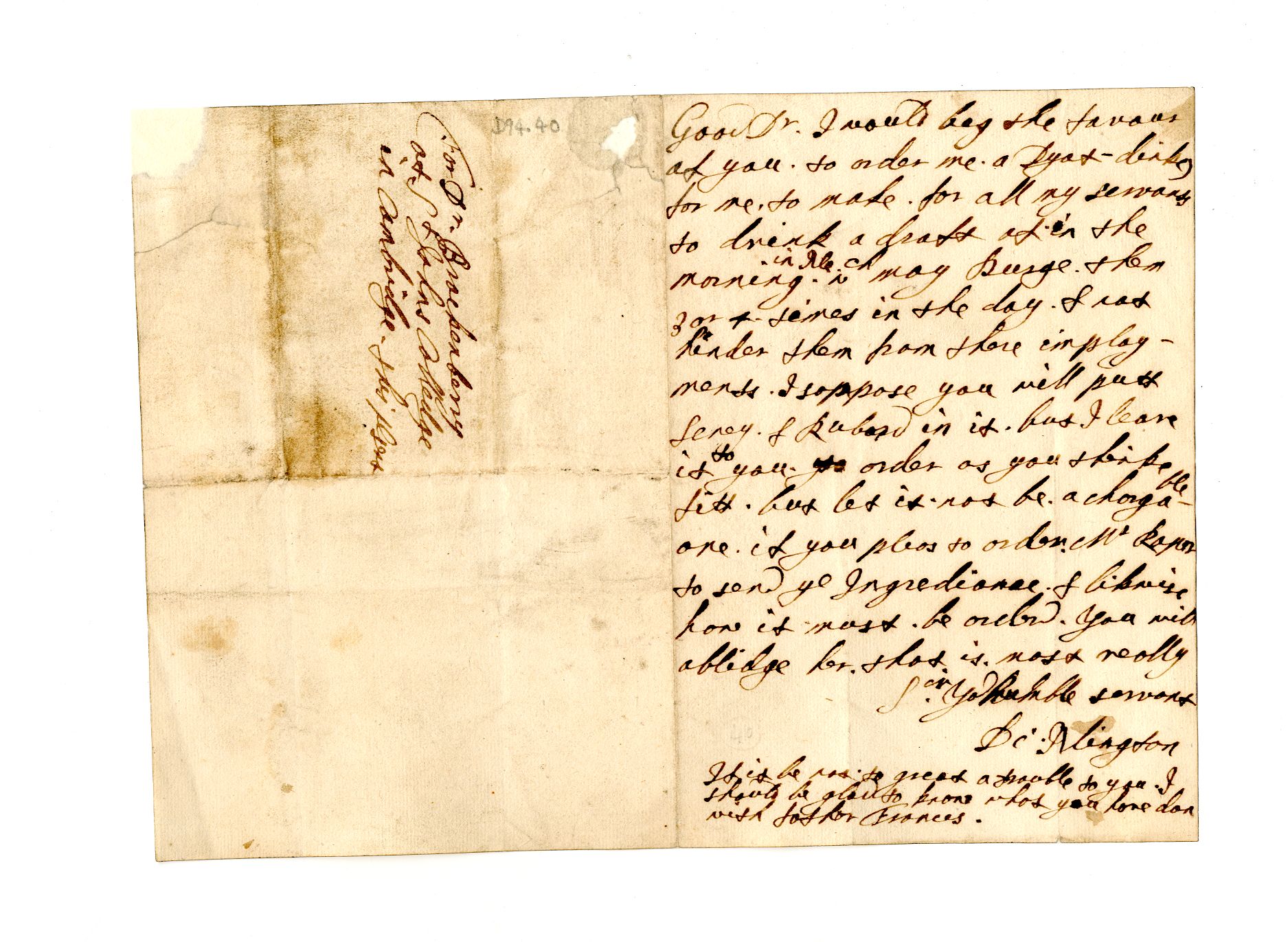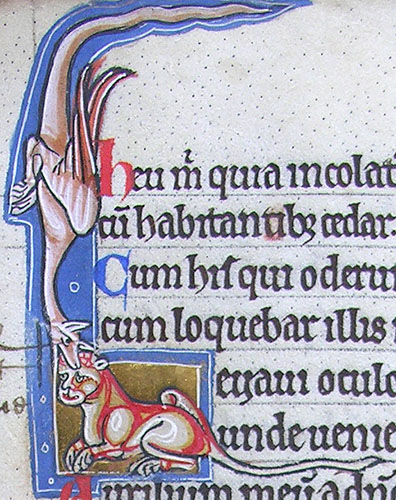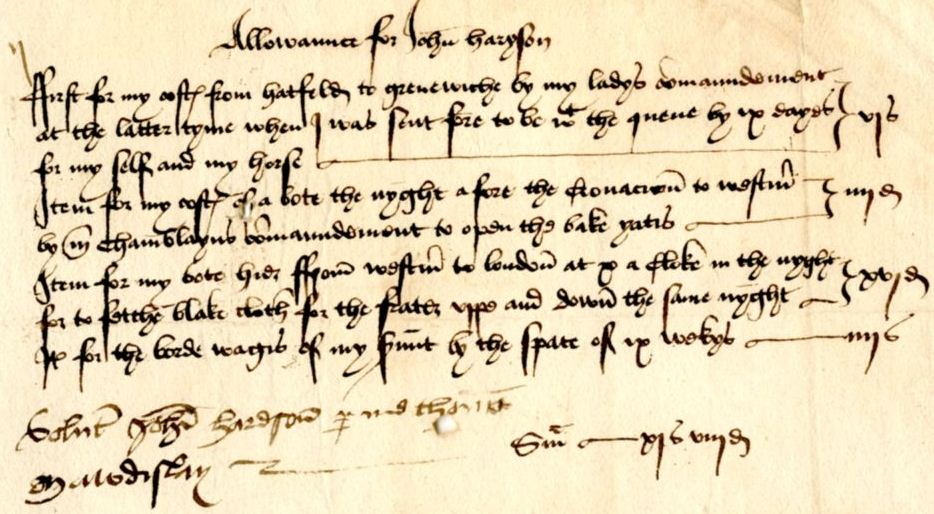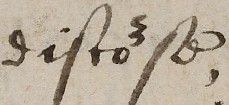Drinking on the job (an exercise in palaeography)
January: for many, a time to look back on the indulgences of the festive period with fondness and regret, and commit (verbally at least) to a punishing regime of exercise and abstinence. Thankfully (or unfortunately?) these days we answer only to ourselves; though our closest acquaintances might encourage us in our health-seeking endeavours, they are unlikely to stand over us and crack the whip, and we can revert to bad habits without fear of admonishment or physical interference. For Dorothy Alington’s employees life was not so easy. Consider this letter from the College Archive (D94/40), penned by Dorothy to the College physician, Pierce Brackenbury, sometime in the latter half of the seventeenth century:
As with any document, before we can appreciate its (in this case somewhat surprising) content, we first have to decipher the text. For documents produced by hand, this is an exercise in palaeography – the study of old handwriting. The following transcription of the text follows the standard convention of transcribing exactly what is written – retaining the original’s spellings and punctuation, indicating where text has been inserted or positioned above the line, placing square brackets around any text that has been added at the transcription stage (for the sake of readability, as in ‘d[r]inke’), and italicising letters that were omitted through the author’s use of standard abbreviations.
--------------------------------------
For Dr. Brackenberry
at St Johns Colledge
in Cambridge. this present
Good Dr. I would beg the favour
of you to order me a Dyat-d[r]inke,
for me to make for all my servants
to drink a draft of in the
morning. in Ale. wch may purge them
3 or 4 times in the day & not
hinder them from there imploy-
ments. I suppose you will putt
Seney & Rubard in it. but I leave
it to you to order as you thinke
fitt. but let it not be a charga-ble
one. if you pleas to order Mr Raper
to send ye Ingrediance & likewise
how it must be orderd you will
oblidge her that is most really
Sir Your humble servant
Do. Alington
If it be not to[o] great a trouble to you I
should be glad to know what you have don[e]
with father Frances.
--------------------------------------
Until the latter half of the sixteenth century most documents were created by scribes, who were trained in the use of standard ‘scripts’ (styles of writing). ‘Set’ scripts, in which the individual letters are formed from separate strokes or elements and therefore appear not joined up, are generally easier to read than ‘cursive’ scripts, in which letters are formed with continuous strokes and attached in natural (improvised) ways to their neighbours. Compare, for example, the set hand known as ‘Textura quadrata’ in this late-twelfth-century psalter from the Library (MS K.30) with the ‘Secretary’ hand in this fifteenth-century receipt from the Archive (D56/179):
By the seventeenth century the use of standard scripts for fixed purposes had dropped off, and more people were writing for themselves than relying on scribes. Although handwriting starts to look more ‘modern’ or familiar in this period, it can be more difficult to decipher than older hands because there is no standard or archetype to use as a guide.
Dorothy Alington’s freestyle hand isn’t the easiest to decipher; some of her letter shapes are poorly or inconsistently formed, and she deploys a variety of abbreviations and contractions. For example, in the address panel we find this curious formulation:
When deciphering unfamiliar hands, from any period, it helps to make comparisons within the document. So, though we might not be able to tell immediately from the context what these words are, we can deduce that the first letter is a ‘t’ because it has the same form as other initial ‘t’s in the document, such as ‘them’ and ‘there’ in line 7:
and ‘to’ and ‘thinke’ in line 10:
and ‘that’ in line 15:
So the first word is ‘this’. What about the second word? An undated, typed transcript filed alongside the original document transcribes the word as ‘please’ – but, following the strokes made by the pen, it is clear that the letter forms on the page do not correspond with the letter shapes required to make ‘please’. You can see what looks like a looped ‘l’ in the second position, but if this was an ‘l’ then the letter before it could not also be a ‘p’. Here, a bit of palaeographic knowledge can help. In medieval documents, a range of special symbols were used for the letter ‘p’ to create shorthand for the frequently occurring Latin prefixes pre, par, per and pro. A loop back through the descending part of the letter indicated the omission of ‘ar’ or ‘er’, so that a word such as persons could be written ‘psons’. Likewise, a loop extending backwards from the lobe (the round part) of the letter denoted the omission of ‘ro’, and a loop extending upwards from the lobe indicated the omission of ‘re’ or ‘ri’. These examples are taken from the Bodleian Library’s online palaeography guide:
particulers persons proportion presume
In the word we need to decipher, Dorothy seems to have created a cursive (joined up) version of example four, looping back through the lobe of the ‘p’ to indicate an abbreviation, then continuing straight on to the next letter. So the ‘p’ in our second mystery word stands for ‘pre’.
The next letter is presumably an ‘s’, similarly formed to those in ‘suppose’ (line 8), ‘Seney’ (line 9) and ‘most’ (line 15):
‘Most’ also helpfully demonstrates that the final letter of the mystery word above is another ‘t’ – similar to the one at the end of ‘servant’, which appears in the polite formula before the signature:
This example points nicely to the penultimate letter of our mystery word: ‘n’. It is more cramped than it is in ‘servant’, but the movement of the pen is essentially the same, making the second mystery word ‘present’. Either she is referring to the letter as a present (noun) ‘For Dr Brackenberry’, or she is instructing the courier to present (verb) the letter to the addressee. There’s no way of knowing!
Another common abbreviation Dorothy uses is ‘Yo’ for ‘Your’ in the line before the signature:
This dates back to medieval times, when a supralineal (i.e. written above the line) squiggle was used to indicate a missing ‘ur’ – as in these examples from the Bodleian:
our discourse,
A further hangover from the medieval period is Dorothy’s use of ‘ye’ for ‘the’ in line 13:
Contrary to popular belief (and an array of charming shop signs around the country), archaic forms of English did not use ‘ye’ for ‘the'. This confusion originates with ‘thorn’ (Þ, þ), a character in the Old English, Gothic, Old Norse and modern Icelandic alphabets that indicates ‘th’ and that when handwritten loosely resembles the letter ‘y’. When printed type was introduced to England from the continent in the late-fifteenth century, typesetters did not have access to the thorn character, as it wasn’t used in Europe, so they deployed the closest character – the ‘y’ – in its place.
Dorothy’s spelling and capitalisation are idiosyncratic (‘Brackenberry’, ‘Colledge’, ‘Dyat’, ‘imployments’, ‘Ingrediance’), though this is no indication of her intellect or ability; standardised spelling didn’t take hold in English until the nineteenth century, when dictionaries became widely available, and prior to that words were spelled phonetically and spellings varied in line with regional accents. She also deploys some specialised, or perhaps local, vocabulary to anticipate the ingredients of the wondrous diet drink. ‘Seney’ could derive from the French senevé, denoting ‘mustard seed, or Senvy seed, whereof mustard is made; also, the herb that bears it’, as defined in Johnian Randle Cotgrave’s A French and English Dictionary (London, 1673; first published 1611). Alternatively it could indicate senna, now widely known as a herbal laxative. ‘Rubard’ is presumably rhubarb. [Shakespeare fans may here recall Macbeth (V.iii.55-56): 'What Rubarb, Cyme, or what Purgative drugge/ Would scowre these English hence?' - where 'cyme' is assumed to be an error for 'cynne', denoting senna.]
We might take a moment to appreciate the evidence that this seventeenth-century doctor provided a personalised service to the community, answering individuals’ wacky requests at least occasionally on a pro bono basis. Brackenbury was licensed to practise medicine in 1662 and received the degree of M.D. in 1665; he was a Fellow of St John’s from 1656 until his death in 1692. The College Archive holds no further information on Dorothy Alington, nor on the fate of her unsuspecting servants. Perhaps they were revivified by their employer’s thoughtful intervention and went on to live long, industrious lives. As for Father Frances – we can only wonder at what the ‘Good Dr.’ did with him.
This Special Collections Spotlight article was contributed on 3 January 2017 by Rebecca Watts, Library Projects Assistant.

















